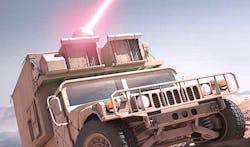Army on the lookout for enabling technologies in tactical laser weapons for light combat vehicles
REDSTONE ARSENAL, Ala. – U.S. Army laser weapons experts are looking for companies able to provide compact, rugged, and modular enabling technologies for a new generation of high-energy laser weapons that could be mounted to light tactical combat vehicles.
These next-generation laser weapons will be designed to shoot down unmanned aerial vehicles (UAVs) and manned reconnaissance aircraft, as well as to provide intelligence, surveillance and reconnaissance.
Officials of the Army Contracting Command at Redstone Arsenal, Ala., issued a request for information (RFI-HEL-2019) on Wednesday for the High Energy Laser Weapon Subsystem Technologies project to find subsystems for beam control, lasers, power storage, power generation, adaptive optics, image trackers, target illuminators, fire-control software and thermal management.
Industry responses will help the Army develop an acquisition strategy to satisfy future laser weapons requirements for light combat vehicles.
High-energy lasers and laser beam control have matured sufficiently to become viable battlefield assets. The High Energy Laser Mobile Test Truck, for example, has a 50-kilowatt-class laser loaded on a 16-ton heavy military truck. Second-generation laser weapons are more compact, and are militarized medium-capacity military trucks and the Stryker armored combat vehicle.
Related: At long last, laser weapons are nearing deployment
The next phase of Army battlefield laser weapons will be small, rugged, and deadly enough for even smaller platforms, perhaps even those like the Joint Light Tactical Vehicle (JLTV).
To do this, Army experts want to identify companies able to provide compact, rugged, and modular laser weapons subsystems for multi-mission high-energy laser weapons that could be mounted on intelligence, surveillance, and reconnaissance vehicles like the JLTV. These laser weapons should be able to destroy or disable UAVs, surveillance aircraft, and similar targets.
Army officials most are interested in laser weapons subsystems like beam controllers, powerful lasers, high-capacity power storage, compact power generation, adaptive optics, image trackers, target illuminators, fire-control software, and thermal management systems.
These laser weapons technologies should be able to provide substantial reductions in laser weapons size, weight, power, and cooling requirements, while increasing overall system efficiency.
Engagement times for future vehicle-mounted laser weapons will be considerably short and the fire-control software should be able to receive the cue, automatically select and maintain an aim-point on the target, and acquire and track targets in bad weather, low visibility, and at night.
Related: Laser weapons show their stuff in real-world conditions
These laser weapons must be able to shut down safely 0.02 seconds, and resume firing within 0.02 seconds from cease fire using agile, low-jitter, and high-slew acceleration. These weapons must be able to start in less than five minutes with a crew of two, and have magazine depths of more than 45 seconds.
These laser weapons should be ruggedized to MIL-STD-810G, and use a modular design approach that incorporates open-systems architectures.
Companies interested should email 10-page white papers no later than 8 March 2019 to the Army's Neisha Mendiola at [email protected].
For questions or concerns contact the Army's Neisha Mendiola by email at [email protected], or by phone at 256-955-0066. More information is online at https://www.fbo.gov/notices/bb216e38f1894a2041fafb36fcb6c04b.
Ready to make a purchase? Search the Military & Aerospace Electronics Buyer's Guide for companies, new products, press releases, and videos

